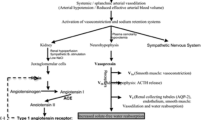Abstract
Previous studies of blood volume (BV) in cirrhosis have either not adjusted BV properly for body size; determined plasma volume from the dilution of labeled albumin 10–20 min postinjection, when some extravascular redistribution has already occurred; and/or not used the correct whole body-peripheral hematocrit ratio (0.82) in calculating whole BV from plasma volume and the peripheral hematocrit. We measured BV with attention to these considerations in 19 patients with cirrhosis and reexamined the determinants of vascular volume and the relationship between vascular volume and sodium retention. BV was calculated as plasma volume (determined from extrapolated plasma activity of intravenously injected [131I]+albumin at time 0) divided by (peripheral hematocrit × 0.82). The result was expressed per kilogram “dry” body weight, determined by subtracting the mass of ascites (measured by isotope dilution; 1 liter=1 kg) from the actual body weight of nonedematous patients. Measured and expressed in this way, BV correlated strongly with esophageal variceal size (r=0.87, P < 0.05), although not with net portal, right atrial, inferior vena caval, or arterial pressure, and was significantly greater in patients with sodium retention as compared to patients without sodium retention. The principal modifier of vascular volume in cirrhosis is vascular capacity, which is probably mainly determined by the extent of the portasystemic collateral circulation. Increased vascular volume in patients with sodium retention as compared to patients without sodium retention supports the “overflow” theory of ascites formation.
Similar content being viewed by others
References
Perera GA: The plasma volume in Laennec's cirrhosis of the liver. Ann Interna Med 24:643–647, 1946
Hiller GI, Huffman ER, Levey S: Studies in cirrhosis of the liver. Relationship between plasma volume, plasma protein concentrations and total circulating proteins. J Clin Invest 28:322–330, 1949
Bateman JC, Schorr HM, Elgvin T: Hypervolemic anemia in cirrhosis. J Clin Invest 28:539–547, 1949
Hyde GM, Berlin NI, Parsons RJ: The blood volume in portal cirrhosis as determined by P32-labelled red blood cells. J Lab Clin Med 39:347–353, 1952
Eisenberg S: Blood volume in patients with Laennec's cirrhosis of the liver as determined by radioactive chromium-tagged red cells. Am J Med 20:189–195, 1956
Murray JF, Dawson AM, Sherlock S: Circulatory changes in chronic liver disease. Am J Med 24:358–367, 1958
Lieberman FL, Reynolds TB: Plasma volume in cirrhosis of the liver: its relation to portal hypertension, ascites and renal failure. J Clin Invest 46:1297–1308, 1967
Maddrey WC, Boyer JL, Sen NN: Plasma volume expansion in portal hypertension. Johns Hopkins Med J 125:171–182, 1969
Ofstad J: The bearing of portal vein congestion on the state of the circulation in liver cirrhosis. Acta Med Scand 168:77–84, 1970
Bernardi M, Trevisani F, Santini C, DePalma R, Gasbarrini G: Aldosterone related blood volume expansion in cirrhosis before and during the early phase of ascites formation. Gut 24:761–7866, 1983
Lieberman FL, Denison EK, Reynolds TB: The relationship of plasma volume, portal hypertension, ascites and renal sodium retention in cirrhosis: The overflow theory of ascites formation. Ann NY Scad Sci 170:202–212, 1970
Marchseini G, Zoli M, Angiolini A, et al: Muscle protein breakdown in liver cirrhosis and the role of altered carbohydrate metabolism. Hepatology 1:294–299, 1981
Parving HH, Ravek L, Lassen NA: Increased transcapillary escape rate of albumin in patients with cirrhosis of the liver. Scand J Clin Lab Invest 37:643–648, 1977
Henriksen JH, Winkler K: Transvascular escape rate of albumin in liver cirrhosis, and its possible role in formation of ascites. Scand J Gastroenterol 12:877–884, 1977
Chaplin H, Mollison PR, Vetter H: The body/venous hematocrit ratio: Its constancy over a wide hematocrit range. J Clin Invest 32:1309–1315, 1953
Diem K, Lentner C (eds): Scientific Tables, 7th ed. CibaGeigy, Basle, Switzerland, 1970, p 537
Nadler NB, Hidalgo JU, Block T: Prediction of blood volume in normal human adults. Surgery 51:224–232, 1962
Reynolds TB, Redeker AG, Geller AH: Wedged hepatic vein pressure. Am J Med 22:341–350, 1957
Boyer TD, Triger DR, Horisawa M, Redeker AG, Reynolds TB: Direct transhepatic measurement of portal vein pressure and direction of flow using a thin needle. Gastroenterology 72:584–589, 1977
Rector WG, Redeker AG: Direct transhepatic assessment of hepatic vein pressure and flow using a thin needle. Gastroenterology 86:1395–1399, 1984
DuBois D, DuBois EF: A formula to estimate the approximate surface area if height and weight be known. Arch Intern Med 17:863–871, 1916
Huff RL, Feller DD: Relation of circulating red cell volume to body density and obesity. J Clin Invest 35:1–7, 1956
Burcharth F, Sorensen TIA, Anderson B: Percutaneous transhepatic portography. III. Relationship between portosystemic collaterals and portal pressure in cirrhosis. Am J Roentgenol 133:1119–1122, 1979
Smith-Laing G, Camilo ME, Dick R, Sherlock S: Percutaneous transhepatic portography in the assessment of portal hypertension. Gastroenterology 78:197–205, 1980
La Fortune M, Marleau D, Breton G, et al: Portal venous system measurements in portal hypertension. Radiology 151:27–30, 1984
Bosch J, Mastai R, Kravetz D, et al: Measurement of azygous blood flow in the evaluation of portal hypertension in patients with cirrhosis: Clinical and hemodynamic correlations in 100 patients. J Hepatol 1:125–139, 1985
Rector WG Jr, Campra J, Rails PW, Charms M: Utility and limitations of splanchnic venous ultrasonography kin the diagnosis of portal hypertension. J Clin Ultrasound 14:689–696, 1986
Rector WG Jr: Portal hypertension: A permissive factor only in the development of ascites and variceal bleeding. Liver 6:221–226, 1986
Greig PD, Blendis LM, Langer B, Taylor BR, Colapinto RF: Renal and hemodynamic effects of peritineovenous shunt II. Long-term effects. Gastroenterology 80:119–125, 1981
Author information
Authors and Affiliations
Additional information
Supported by the Hastings Foundation.
Rights and permissions
About this article
Cite this article
Rector, W.G., Ibarra, F. Intravascular volume in cirrhosis. Digest Dis Sci 33, 460–466 (1988). https://doi.org/10.1007/BF01536032
Received:
Revised:
Accepted:
Issue Date:
DOI: https://doi.org/10.1007/BF01536032




